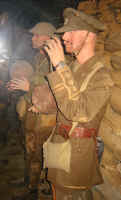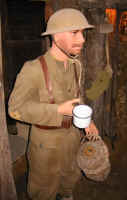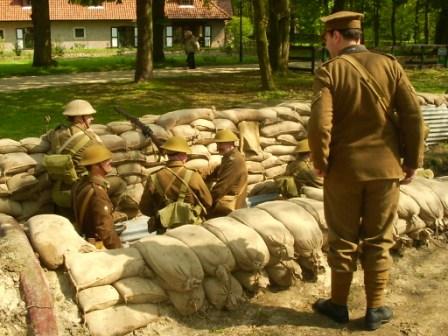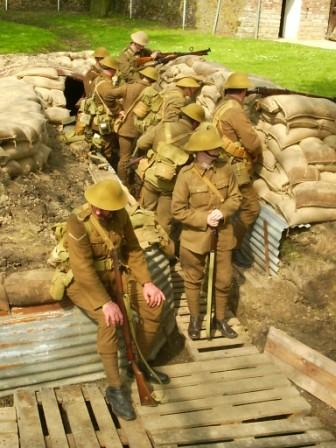
 |
|
#1
|
||||||||||
|
||||||||||
 The British Army was small at the start of World War One, but it was well equipped, well trained and well armed. The lessons of the Boer War had been put to good use. One of the reforms was the adoption of a simple, practical and inconspicuous uniform of khaki cloth. Also, the personal equipment, with strong cotton webbing, was innovative in both material and its design. The Infantry's personal weapon was also well adapted for modern war: the Lee Enfield bolt-action rifle No. l Mark III of .303in. calibre, had a ten-round box magazine that allowed sustained rapid fire, and it was sturdy and reliable. The British Army was small at the start of World War One, but it was well equipped, well trained and well armed. The lessons of the Boer War had been put to good use. One of the reforms was the adoption of a simple, practical and inconspicuous uniform of khaki cloth. Also, the personal equipment, with strong cotton webbing, was innovative in both material and its design. The Infantry's personal weapon was also well adapted for modern war: the Lee Enfield bolt-action rifle No. l Mark III of .303in. calibre, had a ten-round box magazine that allowed sustained rapid fire, and it was sturdy and reliable.   The M1908 cotton webbing equipment was a big advance in design, as it placed no restriction on the chest, could be removed in one piece if necessary, by unfastening the belt, and allowed for the carrying of all the soldier's field necessities by means of an interconnected system. It consisted of a waistbelt, two braces with buckles, a pair of cartridge carriers, with five pouches each, bayonet scabbard, waterbottle carrier, haversack, pack, straps for supporting the pack, plus entrenching tool carriers for head and shaft. The separate items could be arranged in a number of different ways. The standard marching order was ordered thus: on the left hip came the haversack, containing rations, eating utensils, and personal effects. Under this was the bayonet scabbard put, with the entrenching tool helve attached to it. On the right hip was carried the entrenching tool head in its carrier, beneath the water bottle made of blue-enamelled steel covered with The M1908 cotton webbing equipment was a big advance in design, as it placed no restriction on the chest, could be removed in one piece if necessary, by unfastening the belt, and allowed for the carrying of all the soldier's field necessities by means of an interconnected system. It consisted of a waistbelt, two braces with buckles, a pair of cartridge carriers, with five pouches each, bayonet scabbard, waterbottle carrier, haversack, pack, straps for supporting the pack, plus entrenching tool carriers for head and shaft. The separate items could be arranged in a number of different ways. The standard marching order was ordered thus: on the left hip came the haversack, containing rations, eating utensils, and personal effects. Under this was the bayonet scabbard put, with the entrenching tool helve attached to it. On the right hip was carried the entrenching tool head in its carrier, beneath the water bottle made of blue-enamelled steel covered with  khaki cloth. On the front of the body, left and right, were two sets each of five cartridge pouches worn: each pouch could take three five-round clips, giving a load of 150 rounds in all. Attached to the shoulder braces and to diagonal backstraps from the cartridge pouch sets was the pack, which contained the greatcoat, extra clothing, etc. (From October 1914 a modified webbing was introduced, with strap fasteners instead of press studs. The reason was, that when firing prone position or from trenches the original pattern easily came unfastened, and ammo fell out.) khaki cloth. On the front of the body, left and right, were two sets each of five cartridge pouches worn: each pouch could take three five-round clips, giving a load of 150 rounds in all. Attached to the shoulder braces and to diagonal backstraps from the cartridge pouch sets was the pack, which contained the greatcoat, extra clothing, etc. (From October 1914 a modified webbing was introduced, with strap fasteners instead of press studs. The reason was, that when firing prone position or from trenches the original pattern easily came unfastened, and ammo fell out.)NCOs wore the normal rank chevron sequence on their tunic sleeves - one, two or three brown and white herringbone tape chevrons, point down, for Lance-Corporal, Corporal and Sergeant; a crown above three chevrons for Staff or Colour Sergeant; and warrant badges on each forearm for SergeantMajors. Service chevrons might be seen on the Below left and below right forearms of enlisted men, in the form of small blue thread chevrons, each representing six months' service overseas. Vertical gold braid stripes about two inches long might be observed above the left cuff, centred on the sleeve; each indicated a wound in action. Notice that the first bleak winter of the war had a profound effect on the clothing style of the troops. Winter clothing was issued in the form of sleeveless leather jerkins and goatskin coats. The latter appear to have been of at least two types. One was long with shaggy fur and sleeves, the other short and without sleeves, and with smoother fur. In addition to these official items came a number of "comforts" from home (knitted by “Sister Susie” as a popular song would have it) in the form of gloves, scarves, balaclava helmets, and so on. These could be in khaki, grey, or sometimes even navy blue wool. Officers wore several variations on the regulation dress. Headwear was almost invariably the service cap modified by the removal of the wire stiffener which then gave the whole cap its characteristic floppy shape. The Sam Browne belt was worn in many different combinations; the revolver or pistol could be seen on either side, binoculars case could be slung from the belt (or it could be worn on its own strap around the neck), and so on. Legwear also varied; Bedford cords, riding breeches, boots and gaiters, or even puttees were to be seen. The well-known “British Warm” type coat was common, as were various styles of sheepskin jacket from private sources and military tailors. Some officers also wore the goatskin coat as issued to the enlisted men. Later on, the sleveless leather jerkins became very popular, and was many times a standard item worn in cold weather - the sleveless design permitting much more movement than the greatcoats. Mid-war changes  Many of the basic items, as the tunic, trousers and webbing, stayed the same through the war. However, some new items were introduced, that produced the typical Trench War Tommy we are used to see. The principal one was the Mark I steel helmet (called “Brodie” after the man who invented it). It was manufactured from late 1915, and by by July 1916 a million had been delivered. The design gave protection from air-burst shrapnel and shell fragments, and had a weight of some 0.9kg. Badges and symbols were often painted on the helmet. Many of the basic items, as the tunic, trousers and webbing, stayed the same through the war. However, some new items were introduced, that produced the typical Trench War Tommy we are used to see. The principal one was the Mark I steel helmet (called “Brodie” after the man who invented it). It was manufactured from late 1915, and by by July 1916 a million had been delivered. The design gave protection from air-burst shrapnel and shell fragments, and had a weight of some 0.9kg. Badges and symbols were often painted on the helmet. satchel. It was rushed into service after the heavy losses suffered by the first gas attacks, at Ypres on 22-23 April 1915, and consisted of a simple hood of flannel lined with cotton impregnated with phenate-hexamine, a substance which was said to neutralise the effects of the gas. The hood had two glass eye pieces, and a rubber valve through which one exhaled. In 1917 came the M1917 "small box respirator". It was a much better design, consisting of a face mask, of rubberised cloth with two glass eye pieces, connected by an "accordion"-type tube of rubber to a metal filter cartridge. The mask was always carried in a square, flat canvas haversack. The haversack had adjustable fabric sling which allowed it to be carried on the chest in action - the standard position. The gas mask haversack was slung round the body when out of action, or on top of the knapsack on the march. satchel. It was rushed into service after the heavy losses suffered by the first gas attacks, at Ypres on 22-23 April 1915, and consisted of a simple hood of flannel lined with cotton impregnated with phenate-hexamine, a substance which was said to neutralise the effects of the gas. The hood had two glass eye pieces, and a rubber valve through which one exhaled. In 1917 came the M1917 "small box respirator". It was a much better design, consisting of a face mask, of rubberised cloth with two glass eye pieces, connected by an "accordion"-type tube of rubber to a metal filter cartridge. The mask was always carried in a square, flat canvas haversack. The haversack had adjustable fabric sling which allowed it to be carried on the chest in action - the standard position. The gas mask haversack was slung round the body when out of action, or on top of the knapsack on the march.The photos below - courtesy of Bas en Marloes - show re-eneactors, and where take at the the re-opening of the Zillebeke WW1 Museum.    Regarding badges and unit symbols (a big and very confusing subject in itself): coloured cloth divisional (but also corps, brigade and regimental) flashes began to proliferate from 1915. The need to enable quick identification from afar had been seen already in the Boer War, when coloured flashes were sewn onto the helmet covers. This practice was reintroduced gradually from the middle of 1915, and many, but but by no means all, divisions had adopted different systems of battle insignia by mid-1916. The variations are enormous. Higher command signs were normally put on the upper sleeves and sometimes on the helmet sides, worn by all ranks. Regimental signs were at times also worn on the helmet and usually worn on the back below the collar, particularly by officers, for the reason of quick unit identification in the attack: this position was easiest to see for the following waves of troops. Some examples will have to suffice. For example the Royal Dublin Fusiliers wore a red triangle as part of 29th Division, or a green shamrock as part of 16th Division, with a blue diamond on the back and on the helmet sides. The 2nd Royal Irish had no helmet markings. Green shamrocks were worn on both arms. Upon joining the RN Division in May 1918 they adopted a 1.5inch square patch sewn to the sleeve. Red for A company and blue, yellow and green for B, C and D. The 29th Division, veterans of the Gallipolli campaign, were identified by a red cloth triangle sewn to each upper sleeve. The units of the division also wore patches in traditional regimental colours on the back below the collar. In the 1st Bn. Lancashire Fusiliers the red and yellow were arranged in geometric patches identifying the companies-a diamond, red left and yellow right, identified `A' Company. A particularly colourful unit were the 9th Northumberland Fusiliers. On the left side of their helmets was a yellow V on a gosling green square; officers wore this same badge on their backs below the collar. From May 1918, in addition, a red triangle was worn on both shoulders. In October 1917, the unit received a draft of men from the Northumberland Hussars, who were allowed to keep their old cap badges. The 5th Leicesters adopted a yellow half moon in May 1915. This had a 3 inch base and was sewn on to their backs. From 1917 a blue square followed by a yellow bar was worn on the helmet and in 1918 a yellow circle on the arms replaced the half moon. The 7th Leicesters had a red regimental badge painted on to the fronts of their helmets and a 2 x 1 inch yellow patch on their shoulders. Until July 1916, officers had a green triangle 'IV their backs. This battalion also awarded a 1 inch square red cloth badge, which was sewn to the left collar corner, to soldiers who had served with the unit prior to July 1, 1915. And here are some more:
Dominion Troops The Dominion Troops serving in WW1 had a similar but not identical uniform equipment as their British comrades in arms. The Australian troops were, as far as possible, clothed and equipped from home resources. Their own service dress tunic was designed prior to 1914 and was considerably different from the British model. Made of khaki woollen cloth, the tunic was cut very loose, having a turndown collar and four patch pockets with skirts long enough to allow for them; the sleeves were buttoned tight on to the wrist. A bronze badge, a rising sun, was worn by all ranks on both collars. In 1914, the first AEF troops seem to have worn a cloth cap similar to the British pattern. This, however, was soon universally replaced by the famous Australian bush hat with the left side looped up. In the 3rd Division, the brim was unlooped until the formation of the Australian Corps, whereupon they immediately conformed to national style as a sign of approval at finally being able to fight alongside their fellow countrymen. Officers wore this bush hat but in other respects had a uniform very much like British officers, with the open-necked tunic showing collar and tie. The “diggers” were conspicuous for their disregard of dress regulations. In the first part of the war it was considered to be smart to dress unofficial in British issue clothing, principally in tunics and sun hats, and this was partcularly so in Gallipoli. It was of that campaign that an Australian Official Historian made the remark that at times the standard uniform seemed more like kit for swimming rather than fighting. As esprit de corps developed in the Australian formations, they began to cling to their distinctive clothing, but again in 1918, they had to resort to British garments. At that time a reported deficit of 11,000 hats and 12,000 jackets existed and the troops were noted for their raggedness, presumably because of their desire to retain their own patterns of dress. The situation was well summed up by an anonymous Australian infantryman who wrote: “Ragged? Yes I should say that I was. I was four days at Pozieres going about without a seat to my breeches . . . until I wangled a new pair from the British lines.” On arrival in France, the ANZAC troops were issued with hide belting, which stretched as soon as it got wain and caused the heavy packs to sit" down on their backs. Needless to say, this was soon discarded in true Australian style, as soon as the British 1908 pattern equipment could be scrounged. The New Zealanders were basically uniformed in a British style. Their distinguishing feature was a slouch hat, the same as that used by the Australians. At first this hat was dented in the crown, but, later, to disinguish them from the Australians, the crown was raised to a peak with three or four dents rather like the traditional Boy Scout hat. The puggaree (cloth) around the base of the hat was coloured to denote the branch of the wearer: a khaki puggaree with a blue centre line for engineers, green for mounted rifles, red for infantry and white for Army Service Corps. A blue puggaree with a white line was worn by the artillery and blue with red edges by the Army Ordnance Corps. The first Canadian contingent, which eventually became the 1 st Canadian Division, landed in England in September 1914. Continual re-inforcements from the Dominion eventually led to the formation of four infantry divisions and an independent cavalry brigade. A separate Canadian Corps was formed in September 1915. The Canadian forces were uniformed in the British style, highland kilts wearing the Scottish doublet. The tunic, cap or Glengarry, kilt apron or trousers and puttees, were coloured khaki. Buttons were gilding die struck, except in rifle regiments who had them blackened. Officers wore the opennecked tunic with collar and tie. Official Canadian dress regulations show distinctive shoulder straps on the officer's tunic, but it seems likely that the colours listed below were, in fact, only used on greatcoats, as in the British Army. The colours were as follows: 1/4-inch cloth edging around the strap, coloured yellow for cavalry, scarlet for infantry and white for Army Service Corps. A dark blue edge with scarlet centre loop, passing around the button for artillery, this scheme being reversed for engineers. White edging with an inner loop of yellow for Army Pay Corps, red for Ordnance Stores Corps, maroon for the Veterinary Corps and cherry for the Army Medical Corps. Most troops were issued with the Oliver leather equipment when in Canada, this being exchanged for the 1908 pattern web equipment upon arrival in England. Apart from numerous supporting units, the South African raised three brigades, each of four battalions, for overseas service. Two of these brigades, together with ten regiments of Mounted Rifles, served in East Africa, whilst the Ist Brigade, after a short spell of duty in the Middle East, served on the Western Front. The South African Brigade was attached to the 9th Scottish Division and fought with that unit on the Somme in 1916, where they took Delville Wood, today the site of a South African War Memorial. In 1918 they were transferred to the 66th Division. The four component battalions were numbered 1 to 4. Their styles of dress corresponded with those of the British Army. |
| Sponsored Links |
 |
|
|
 Similar Threads
Similar Threads
|
||||
| Thread | Thread Starter | Forum | Replies | Last Post |
| Only The Uniforms Change! | HARDCORE | General Posts | 2 | 11-08-2007 08:58 AM |
| Army Uniforms | Robert Ryan | General Posts | 0 | 06-08-2006 09:27 AM |
| Uniforms | cadetat6 | General Posts | 5 | 09-24-2005 08:18 PM |
| G.I. Uniforms | cadetat6 | General Posts | 0 | 11-19-2004 04:44 PM |
| Iraqi's in American and British uniforms. | GoldenDragon | Gulf War | 6 | 03-19-2003 02:05 AM |


|